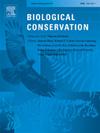Can strategic protected area expansion solve the insufficient representation of biodiversity in protected area networks? A case study from South Africa
IF 4.9
1区 环境科学与生态学
Q1 BIODIVERSITY CONSERVATION
引用次数: 0
Abstract
Strategic protected area expansion has been proposed as a solution to the inequitable representation of biodiversity in existing protected area networks, but its effectiveness remains untested. South Africa implemented a National Protected Area Expansion Strategy (NPAES) in 2008, which provided the opportunity to examine the role that strategic decision-making played in guiding protected area expansion towards biodiversity priority areas over the following 12 years. The study evaluated three outcomes as evidence for strategic expansion: alignment of annual protected area expansion with NPAES goals, probability of expansion in priority versus non-priority areas, and shifts in expansion drivers from land availability to biodiversity priorities. While post-NPAES expansion generally aligned with its goals, no evidence could be found that this result was due to strategic decision-making. Results reinforce concerns that in under-resourced conservation strategies, ambitious targets can undermine the achievement of strategic objectives. Strategies containing a mix of conservation interventions complementary to the constraints on strategic protected area expansion will support better outcomes for biodiversity.
求助全文
约1分钟内获得全文
求助全文
来源期刊

Biological Conservation
环境科学-环境科学
CiteScore
10.20
自引率
3.40%
发文量
295
审稿时长
61 days
期刊介绍:
Biological Conservation is an international leading journal in the discipline of conservation biology. The journal publishes articles spanning a diverse range of fields that contribute to the biological, sociological, and economic dimensions of conservation and natural resource management. The primary aim of Biological Conservation is the publication of high-quality papers that advance the science and practice of conservation, or which demonstrate the application of conservation principles for natural resource management and policy. Therefore it will be of interest to a broad international readership.
 求助内容:
求助内容: 应助结果提醒方式:
应助结果提醒方式:


